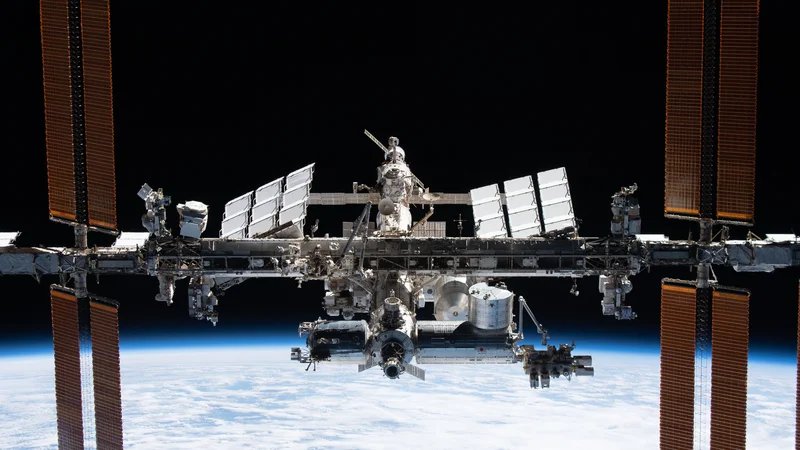This week, residents of Central Texas will have two opportunities to see the International Space Station. On Wednesday evening, if the sky is clear, it will appear on the northwestern horizon at 7:55 PM, travel directly overhead, and vanish six minutes later in the southeast. From the ground, it is a silent, brilliant point of light, moving at a speed of 17,500 miles per hour, reflecting sunlight long after it has set on Earth. It is a predictable, elegant arc across the night sky.
This serene view from our backyards is the dominant public perception of the ISS: a symbol of human achievement, a steady presence, and a clean, futuristic laboratory where we are methodically paving the way to the Moon and Mars. NASA’s public-facing materials reinforce this narrative, describing the station as a platform that has allowed us to “master a new environment” and create “self-sufficiency in space.” The story is one of progress: astronauts harvest chili peppers, recycle 98% of their water, and 3D-print tools, all as preparatory steps for deep space exploration. The ISS, in this telling, is the first, triumphant chapter of a much grander story.
The operational data, however, suggests a different narrative. The story of what the International Space Station is used for is less about preparing for a hypothetical future on Mars and more about the grueling, minute-by-minute battle to survive the present in low-Earth orbit. The discrepancy between the marketing and the machine's daily reality is significant.
An Engineering Marvel or a High-Stakes Maintenance Log?
An Analysis of Operational Stress
The official narrative of mastering the environment becomes difficult to reconcile with the logged history of near-catastrophes. On July 16, 2013, astronaut Luca Parmitano’s spacewalk was aborted when his helmet began filling with water from a malfunctioning cooling system. He was, for all practical purposes, drowning inside his own suit in the vacuum of space. In August 2018, the crew traced a persistent, slow cabin pressure drop to a 2-millimeter hole in a docked Soyuz MS-09 spacecraft—a pinprick that, if left unattended, would have eventually depressurized the station. These are not the hallmarks of a mastered environment; they are indicators of an extraordinarily hostile one where the margin for error is functionally zero.
I've analyzed risk models for complex financial systems, and the cascading failure potential aboard the ISS is striking. The public narrative focuses on triumphs like growing vegetables, while the operational logs read like a series of averted disasters. In July 2021, the newly docked Russian Nauka module spontaneously fired its thrusters, sending the entire station into an uncontrolled spin. The outpost rotated for over an hour—to be more exact, about 540 degrees—before flight controllers on two continents managed to wrestle it back into a stable orientation by firing thrusters on other modules. The incident was attributed to a software glitch, a reminder that the station (estimated at over $100 billion, though precise accounting is notoriously difficult) remains vulnerable to the most mundane of errors.

These high-profile events are merely outliers in a constant stream of operational challenges. A coolant leak from a Soyuz MS-22 in 2022, likely caused by a micrometeorite impact through a hole just 0.8mm wide, stranded its three-person crew on the station for months until a replacement "lifeboat" could be launched. This highlights a core reality the PR materials tend to gloss over: the ISS is not a self-sufficient colony. It is an aging, interdependent outpost utterly reliant on a fragile supply chain from Earth and a precarious political partnership. Its main flight computers, for instance, are located in the Russian Zvezda module. The segments are so operationally entangled that simply closing the hatches, should the aging Russian hardware degrade further, is not a viable long-term solution.
The station’s true legacy, then, may not be the technologies it’s testing for Mars. The most valuable data it has generated over its 25 years of continuous human presence is not on hydroponics or 3D printing metal. It is the unglamorous, exhaustive, and invaluable dataset on long-term systems fatigue, material degradation, and crisis management in a closed, high-stakes environment. It is a 25-year-long case study in keeping a complex machine running far beyond its warranty.
As the ISS approaches its scheduled de-orbit in 2030, the question of its value becomes clearer. It wasn't the clean stepping-stone to the planets we were sold. It was something far more important: a laboratory for understanding failure. Every emergency spacewalk, every patched leak, every software workaround has taught us more about the brutal realities of living in space than any successful experiment on crop growth. The view from Earth is of a flawless, shining star. The view from the flight logs is of a magnificent, fragile machine held together by relentless human ingenuity.
###
A High-Orbit Balance Sheet
###
The primary return on investment for the International Space Station was never going to be a direct path to Mars. Its real value is as a 25-year, multi-billion-dollar audit of just how staggeringly difficult it is to keep humans alive 250 miles up. It is a monument not to exploration, but to maintenance. And in the business of deep space, that lesson may prove to be the most valuable of all.
Reference article source:









